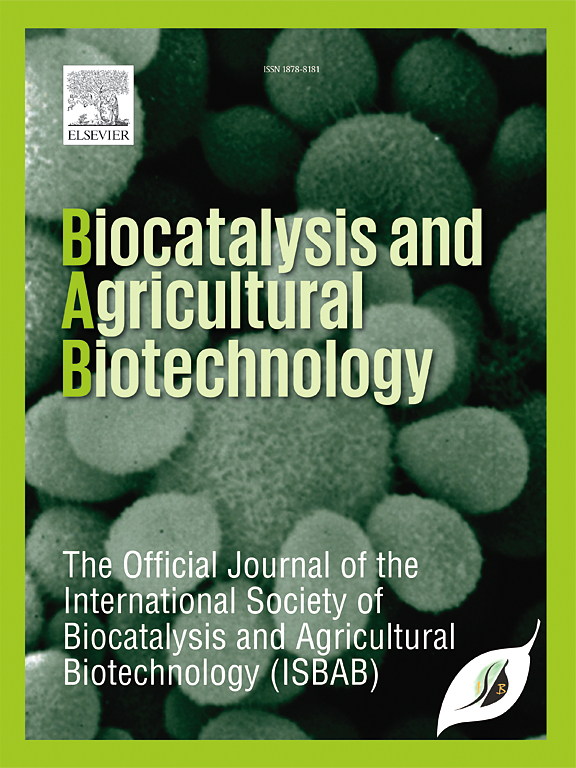新分离到的具有嘌呤核苷降解活性的短乳酸杆菌LABC170和发酵乳酸杆菌LABC37在预防和治疗小鼠高尿酸血症方面具有益生菌作用
IF 3.4
Q2 BIOTECHNOLOGY & APPLIED MICROBIOLOGY
引用次数: 0
摘要
嘌呤核苷被认为是导致高尿酸血症的关键因素。在这项研究中,我们从不同来源分离了 81 种乳酸菌(LAB),并评估了它们的嘌呤核苷酸酶(PNase)活性。其中,Levilactobacillus brevis LABC170 能完全降解鸟苷和肌苷(100%),而 Limosilactobacillus fermentum LABC37 则表现出较高的降解率(92 ± 1.72 % 鸟苷,88 ± 4.6 % 肌苷)。这两种菌株都具有益生特性,包括耐酸性和对 Caco-2 细胞的粘附性。在高尿酸血症诱导的小鼠中,服用 LAB 能显著降低血尿酸(高尿酸血症组:2.7 ± 0.5 mg/dL vs. LAB 处理组:1.8 ± 0.2 to 2.2 ± 0.3 mg/dL,p < 0.05)。值得注意的是,尽管L. fermentum LABC37的PNase活性低于L. brevis LABC170,但在高尿酸血症诱导前给药时,L. fermentum LABC37能更有效地降低尿酸,这表明益生菌的作用超出了PNase活性。这些发现突显了PNase活性的菌株特异性差异,以及新分离的LAB菌株在高尿酸血症预防和治疗中的潜在应用。本文章由计算机程序翻译,如有差异,请以英文原文为准。
The newly-isolated Levilactobacillus brevis LABC170 and Limosilactobacillus fermentum LABC37 with purine nucleosides degradation activity show probiotic efficacy in prevention and treatment of hyperuricemia in mice
Purine nucleosides are recognized as key contributors to hyperuricemia. In this study, we isolated 81 Lactic Acid Bacteria (LAB) from various sources and evaluated their purine nucleosidase (PNase) activity. Among them, Levilactobacillus brevis LABC170 exhibited complete degradation of guanosine and inosine (100 %), while Limosilactobacillus fermentum LABC37 showed high degradation rates (92 ± 1.72 % guanosine, 88 ± 4.6 % inosine). Both strains demonstrated probiotic characteristics, including acid resistance and adhesion to Caco-2 cells. In hyperuricemia-induced mice, LAB administration significantly reduced blood uric acid (hyperuricemia group: 2.7 ± 0.5 mg/dL vs. LAB-treated groups: 1.8 ± 0.2 to 2.2 ± 0.3 mg/dL, p < 0.05). Notably, L. fermentum LABC37, despite lower PNase activity than L. brevis LABC170, was more effective in reducing uric acid when administered before hyperuricemia induction, suggesting probiotic effects beyond PNase activity. These findings highlight the strain-specific variations in PNase activity and the potential application of newly isolated LAB strains in hyperuricemia prevention and treatment.
求助全文
通过发布文献求助,成功后即可免费获取论文全文。
去求助
来源期刊

Biocatalysis and agricultural biotechnology
Agricultural and Biological Sciences-Agronomy and Crop Science
CiteScore
7.70
自引率
2.50%
发文量
308
审稿时长
48 days
期刊介绍:
Biocatalysis and Agricultural Biotechnology is the official journal of the International Society of Biocatalysis and Agricultural Biotechnology (ISBAB). The journal publishes high quality articles especially in the science and technology of biocatalysis, bioprocesses, agricultural biotechnology, biomedical biotechnology, and, if appropriate, from other related areas of biotechnology. The journal will publish peer-reviewed basic and applied research papers, authoritative reviews, and feature articles. The scope of the journal encompasses the research, industrial, and commercial aspects of biotechnology, including the areas of: biocatalysis; bioprocesses; food and agriculture; genetic engineering; molecular biology; healthcare and pharmaceuticals; biofuels; genomics; nanotechnology; environment and biodiversity; and bioremediation.
 求助内容:
求助内容: 应助结果提醒方式:
应助结果提醒方式:


